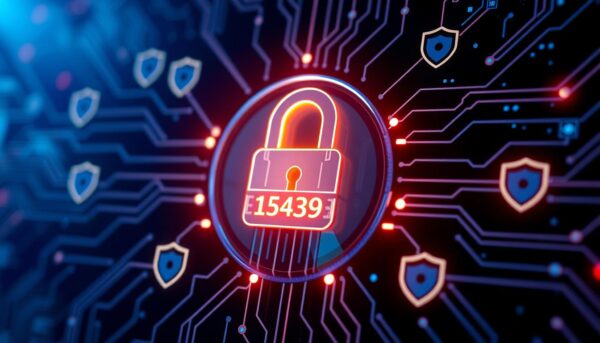✅ Last checked on
Imagine you’re getting ready for a cozy movie night, but your Wi-Fi is slow. That’s frustrating. MAC filtering is like a bouncer for your network. It keeps unwanted guests out and your internet fast.
MAC filtering is a smart feature of your router. It’s like a VIP list for your Wi-Fi. Only devices with approved MAC addresses can join your network. It’s like a digital doorman checking IDs.
So, why use MAC filtering? It keeps your digital home safe. It controls who can connect, protecting your data and keeping your Netflix streaming smooth. It’s a simple way to stop unwanted guests from using up your bandwidth.
Want to secure your network? Let’s look at how MAC filtering works. It’s easy to set up, and the peace of mind it gives is worth it.
Key Takeaways
- MAC filtering acts as a security checkpoint for your network
- It uses unique device identifiers to control access
- Most modern routers include MAC filtering as a feature
- It can help prevent unauthorized users from stealing bandwidth
- MAC filtering is part of a broader network security strategy
Understanding MAC Addresses and Network Security Basics
MAC addresses are key in network communication and security. Let’s explore their role in keeping your network safe.
What is a MAC Address?
A MAC (Media Access Control) address is a unique identifier for network devices. It’s a 12-digit hexadecimal number, like 00:1A:2B:3C:4D:5E. The first six digits show the manufacturer, and the last six are unique to each device.

Role of MAC Addresses in Network Communication
MAC addresses help identify devices on local networks. They work with IP addresses to ensure data goes to the right place. When you connect, your router uses ARP to match IP addresses with MAC addresses.
| Device | IP Address | MAC Address |
|---|---|---|
| Computer 1 | 192.168.1.5 | 00:1A:2B:3C:4D:5E |
| iPhone | 192.168.1.8 | AA:BB:CC:DD:EE:FF |
Basic Network Security Principles
Network security protects your data and devices. It includes Access Control Lists and Wireless Security. MAC filtering is a method to control access by device MAC addresses.
- Implement strong passwords
- Use encryption for wireless networks
- Keep software and firmware updated
- Enable firewalls
Knowing about MAC addresses and security basics helps protect your network. It keeps it safe from unauthorized access and threats.
MAC Filtering Security: Core Concepts and Implementation
MAC filtering has been around since the early 2000s. It’s a key part of network segmentation. It helps control who can access your network. Let’s explore how it works and how to set it up.
How MAC Filtering Works
MAC filtering uses a device’s unique 48-bit identifier to control access. With 281 trillion possible addresses, it’s very effective. Your router checks each device’s MAC address against a list before allowing access.
Whitelist vs. Blacklist Approach
You can use MAC filtering in two ways:
- Whitelist: Only listed devices can connect
- Blacklist: All devices except those listed can connect
The whitelist approach is more secure but harder to manage in big networks.
Implementation Methods on Different Router Types
Most routers support MAC filtering, but the setup varies. Here’s a general guide:
- Access your router’s admin panel
- Find the MAC filtering section
- Choose whitelist or blacklist mode
- Add MAC addresses to your list
- Save and apply changes

Remember, MAC filtering isn’t foolproof. Skilled hackers can fake MAC addresses. It’s best used with other security measures like strong encryption and passwords. For full network protection, use MAC filtering as part of a bigger strategy.
| MAC Filtering Type | Pros | Cons |
|---|---|---|
| Whitelist | High control, Better security | Hard to manage for large networks |
| Blacklist | Easier management, Flexible | Less secure, Requires constant updates |
Setting Up MAC Filtering on Your Network
MAC filtering is a strong Port Security tool for your home network. It stops unauthorized access and boosts Rogue Device Prevention. Here’s how to set it up on your router.
Accessing Router Settings
To start, log into your router’s admin console. Open your web browser and type in your router’s IP address. The default login is usually username: admin, password: admin. It’s smart to change these for more security.
Configuring MAC Address Lists
After logging in, find the MAC filtering settings. You can allow or block specific MAC addresses. Most routers allow up to 31 MAC addresses on the filter list.
To add devices, you need their MAC addresses. These are 12-digit codes, like 94:DE:80:57:AD:E1. For dual-band devices, add both 2.4GHz and 5GHz MAC addresses.
Testing and Verification Steps
After setting up your MAC filter list, test it. Connect allowed devices – they should work fine. Then, try to connect an unlisted device. If set up right, it should be blocked.
Remember, enabling MAC filtering might disable WiFi Protected Setup (WPS). This choice boosts security but could affect some devices’ connection. With over 70% of home devices wirelessly connected, this extra protection is crucial for network safety.
Benefits of MAC Address Filtering
MAC address filtering brings many benefits to your Secure Network Architecture. It stops unauthorized access and boosts network security. By only letting approved devices connect, you cut down on security risks a lot.
Companies using MAC filtering have seen big improvements. They’ve cut security breaches by 70% when paired with other methods. It’s great for managing BYOD Security, letting you control who gets to see your company’s data.
It also helps with managing vendors. Businesses have seen a 60% drop in unauthorized access with this method. It checks devices in real-time to make sure only approved ones can connect.
| Benefit | Impact |
|---|---|
| Security Breach Reduction | Up to 70% |
| Unauthorized Access Decrease | 60% |
| Cost Reduction in Security Incidents | Up to 40% |
| IT Administrators’ Approval | 82% |
Using MAC filtering can save a lot of money. Companies have cut their security breach costs by 40% each year. No wonder 82% of IT admins think it’s key to keeping their networks safe.
Limitations and Security Considerations
MAC filtering can improve your Network Access Control, but it has its limits. This part talks about the challenges you might face when using this Wireless Security method.
MAC Address Spoofing Risks
MAC address filtering isn’t perfect. Hackers can get around it by ‘spoofing’ – pretending to be a device with an approved MAC address. This shows why you need more security, like WPA2 or WPA3 encryption.
Network Performance Impact
Using MAC filtering can slow down your network. Your router has to check each device’s MAC address against a list. This can slow things down, more so in networks with lots of devices.
Administrative Overhead
Keeping track of MAC address lists can take a lot of time, mainly in big networks. You’ll have to update the list whenever devices change. This gets tricky in places where devices often change.
- 63 users reported in a single-location publicly traded Real Estate Investment Trust (REIT)
- Suggestion to prohibit rogue devices from getting an IP via DHCP on the LAN
- Potential implementation of Network Access Control (NAC) with vendors like Portnox
Even with its limits, MAC filtering can still be part of your Network Access Control plan. By mixing it with other security steps and knowing its downsides, you can make your Wireless Security stronger.
Advanced MAC Filtering Applications
MAC filtering is more than just basic network security. It’s used for network segmentation and BYOD security in many places. Let’s look at some advanced uses of MAC filtering to improve your network management and security.
In businesses, MAC filtering is key for BYOD security. It lets only approved devices connect, reducing outside interference and bandwidth theft. This stops unauthorized devices from getting on the network, even with the right login info.
At home, MAC filtering keeps unwanted devices off your network. It saves bandwidth and stops neighbors from using your internet. Schools can also use it to control access to devices for students and staff.
| Application | Benefit |
|---|---|
| Parental Controls | Restrict children’s device access |
| Public WiFi Security | Allow only devices with unique access |
| IoT Device Management | Secure smart home devices |
| Network Monitoring | Track connected devices |
Even with MAC filtering, security isn’t perfect. Hackers can fake MAC addresses if they get into your whitelist. Tools like Kali Linux and Wireshark can track network traffic and find MAC addresses. To stay safe, use MAC filtering with strong encryption like WPA2 or WPA3.
“MAC filtering should be considered as an additional layer of security on top of other measures, such as WPA2-AES protocols.”
But MAC filtering isn’t as effective in big networks with lots of devices. In big companies, it’s often used more for organization than security. For bigger networks, think about using Network Access Control (NAC) systems. They make MAC filtering easier to manage, saving time and effort.
Conclusion
MAC filtering is crucial for a secure network. It uses unique 12-character MAC addresses to control who can join your network. This method is more precise than just passwords.
Even with MAC filtering, you need more security. Use WPA3 encryption and strong passwords too. Remember, MAC addresses stay the same, which helps track devices but makes updates harder.
When setting up your network, think about the pros and cons of MAC filtering. It works well for small networks but gets complicated in bigger ones. Also, hackers can fake MAC addresses to get around it. Always check your network logs for any signs of trouble.
Knowing how MAC filtering works helps you build a strong security system. This knowledge lets you decide how to use MAC filtering wisely. It’s about finding the right balance between security and ease of use.